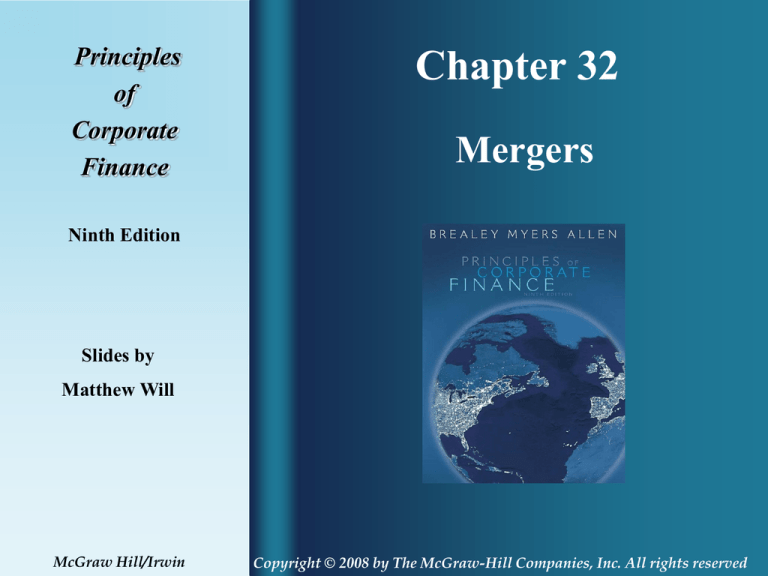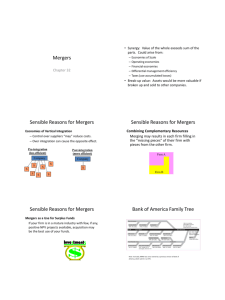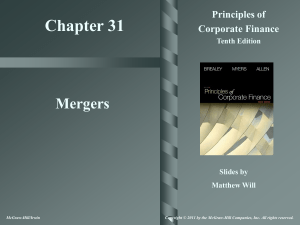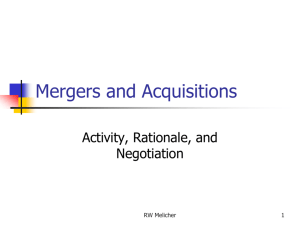
Principles
of
Corporate
Finance
Chapter 32
Mergers
Ninth Edition
Slides by
Matthew Will
McGraw Hill/Irwin
Copyright © 2008 by The McGraw-Hill Companies, Inc. All rights reserved
32- 2
Topics Covered
Sensible Motives for Mergers
Some Dubious Reasons for Mergers
Estimating Merger Gains and Costs
The Mechanics of a Merger
Proxy Fights, Takeovers, and the Market for
Corporate Control
Mergers and the Economy
32- 3
Recent Mergers
Industry
Acquiring Company
Selling Company
Payment
($billions)
Telecoms
AT&T
Bell South
72.7
Electricity
Enel (Italy) and Acciona (Spain)
Endesa (Spain)
58.7
Banking
Banca Intesa (Italy)
Sanpaolo IMI (Italy)
37.7
Banking
Bank of America
MBNA
35.8
Oil
Conoco Phillips
Burlington Resources
35.4
Steel
Mittal Steel (Netherlands)
Arcelor (Luxembourg)
32.2
Telecoms
Telefonica (Spain)
O 2 (U.K.)
31.7
Medical devices
Boston Scientific
Guidant
27.9
Banking
Wachovia
Golden West Financial
25.5
Pharmaceuticals
Bayer (Germany)
Schering (Germany)
20.6
32- 4
Sensible Reasons for Mergers
Economies of Scale
A larger firm may be able to reduce its per unit cost by
using excess capacity or spreading fixed costs across more
units.
Reduces costs
$
$
$
32- 5
Sensible Reasons for Mergers
Economies of Vertical Integration
– Control over suppliers “may” reduce costs.
– Over integration can cause the opposite effect.
Pre-integration
(less efficient)
Post-integration
(more efficient)
Company
S
S
S
S
S
Company
S
S
S
32- 6
Sensible Reasons for Mergers
Combining Complementary Resources
Merging may results in each firm filling in
the “missing pieces” of their firm with
pieces from the other firm.
Firm A
Firm B
32- 7
Sensible Reasons for Mergers
Mergers as a Use for Surplus Funds
If your firm is in a mature industry with few, if
any, positive NPV projects available, acquisition
may be the best use of your funds.
32- 8
Bank of America Family Tree
Note: Ironically, MBNA was once owned by a previous version of Bank of
America, which sold it in an IPO.
32- 9
Dubious Reasons for Mergers
Diversification
– Investors should not pay a premium for
diversification since they can do it themselves.
32- 10
Dubious Reasons for Mergers
The Bootstrap Game
Acquiring Firm has high P/E ratio
Selling firm has low P/E ratio (due to low
number of shares)
After merger, acquiring firm has short term
EPS rise
Long term, acquirer will have slower than
normal EPS growth due to share dilution.
32- 11
Dubious Reasons for Mergers
The Bootstrap Game
World Enterprises
(before merger)
EPS
Price per share
P/E Ratio
Number of shares
Total earnings
Total market value
Current earnings
per dollar invested
in stock
$
$
$
$
$
2.00
40.00
20
100,000
200,000
4,000,000
World Enterprises
(after buying Muck
and Slurry)
Muck and Slurry
$
2.00 $
2.67
$
20.00 $
40.00
10
15
100,000
150,000
$
200,000 $
400,000
$
2,000,000 $
6,000,000
0.05 $
0.10 $
0.067
32- 12
Dubious Reasons for Mergers
Earnings per
dollar invested
(log scale)
World Enterprises (after merger)
World Enterprises (before merger)
Muck & Slurry
.10
.067
.05
Now
Time
32- 13
Estimating Merger Gains
Questions
– Is there an overall economic gain to the
merger?
– Do the terms of the merger make the company
and its shareholders better off?
????
PV(AB) > PV(A) + PV(B)
32- 14
Estimating Merger Gains
Gain PV AB ( PV A PVB ) PV AB
Cost Cash paid PVB
NPV gain lost
PV AB ( cash PVB )
32- 15
Estimating Merger Gains
Example – Two firms merge creating $25 million
in synergies. If A buys B for $65 million, the cost is
$15 million.
PVA $200
PVB $50
Gain PVAB $25
PVAB $275million
Cost Cash paid PVB
65 50 $15million
32- 16
Estimating Merger Gains
Example – The NPV to A will be the difference
between the gain and the cost.
NPVA 25 15 $10million
NPVA wealth wit h merger - wealth wi thout merger
( PVAB Cash) PVA
(275 65) 200
$10million
32- 17
Estimating Merger Gains
Economic Gain
Economic Gain = PV(increased earnings)
=
New cash flows from synergies
discount rate
32- 18
Accounting for a Merger
Accounting for the merger of A Corp and B Corp
assuming that A Corp pays $18 million for B Corp.
Initial Balance Sheets
NWC
FA
A Corporation
20
30
80
70
100
100
D
E
NWC
FA
B Corporation
1
0
9
10
10
10
Balance Sheet of AB corporation
NWC
21
30
D
FA
89
88
E
Goodwill
118
118
D
E
32- 19
Oracle / PeopleSoft
32- 20
The Mechanics of a Merger
Taxable Merger
Tax-free Merger
Impact on Captain B
Captain B must recognize a
$30000 capital gain.
Capital gain can be deferred until
Captain B sells the Baycorp
shares.
Impact on baycorp
Boat is revalued at $280000. Tax
depreciation increases to
$280000/10=$28000 per year
(assuming 10 years of remaining
life)
Boat's value remains at $150000,
and tax depreciation continues at
$15000 per year.
32- 21
Takeover Methods
Tools Used To Acquire Companies
Proxy Contest
Tender Offer
Acquisition
Leveraged
Buy-Out
Merger
Management
Buy-Out
32- 22
Takeover Defenses
32- 23
Takeover Defenses
White Knight - Friendly potential acquirer sought
by a target company threatened by an unwelcome
suitor.
Shark Repellent - Amendments to a company
charter made to forestall takeover attempts.
Poison Pill - Measure taken by a target firm to avoid
acquisition; for example, the right for existing
shareholders to buy additional shares at an
attractive price if a bidder acquires a large holding.
32- 24
Mergers (1962-2006)
Number of Deals
12,000
10,000
8,000
6,000
4,000
2,000
0
32- 25
Web Resources
Click to access web sites
Internet connection required
www.cfonews.com
www.mergernetwork.com
www.mergerstat.com
www.globalfindata.com









